Unit10 I’d like some noodles说课稿
- 格式:doc
- 大小:53.00 KB
- 文档页数:5
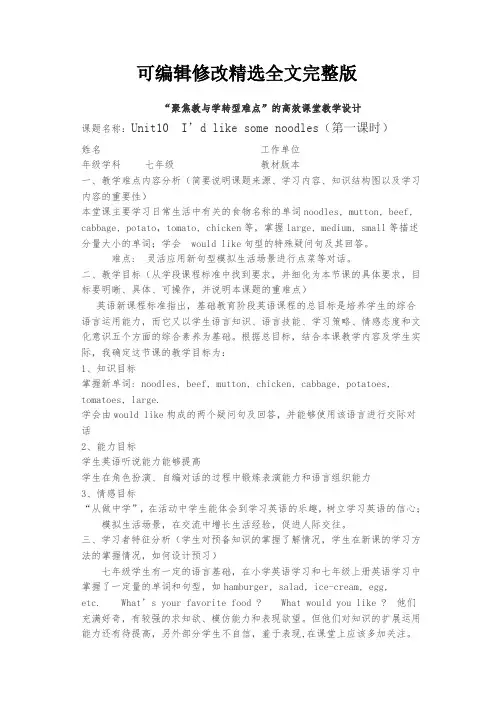
可编辑修改精选全文完整版“聚焦教与学转型难点”的高效课堂教学设计课题名称:Unit10 I’d like some noodles(第一课时)姓名工作单位年级学科七年级教材版本一、教学难点内容分析(简要说明课题来源、学习内容、知识结构图以及学习内容的重要性)本堂课主要学习日常生活中有关的食物名称的单词noodles, mutton, beef, cabbage, potato,tomato, chicken等,掌握large, medium, small等描述分量大小的单词;学会would like句型的特殊疑问句及其回答。
难点:灵活应用新句型模拟生活场景进行点菜等对话。
二、教学目标(从学段课程标准中找到要求,并细化为本节课的具体要求,目标要明晰、具体、可操作,并说明本课题的重难点)英语新课程标准指出,基础教育阶段英语课程的总目标是培养学生的综合语言运用能力,而它又以学生语言知识、语言技能、学习策略、情感态度和文化意识五个方面的综合素养为基础。
根据总目标,结合本课教学内容及学生实际,我确定这节课的教学目标为:1、知识目标掌握新单词: noodles, beef, mutton, chicken, cabbage, potatoes, tomatoes, large.学会由would like构成的两个疑问句及回答,并能够使用该语言进行交际对话2、能力目标学生英语听说能力能够提高学生在角色扮演、自编对话的过程中锻炼表演能力和语言组织能力3、情感目标“从做中学”,在活动中学生能体会到学习英语的乐趣,树立学习英语的信心;模拟生活场景,在交流中增长生活经验,促进人际交往。
三、学习者特征分析(学生对预备知识的掌握了解情况,学生在新课的学习方法的掌握情况,如何设计预习)七年级学生有一定的语言基础,在小学英语学习和七年级上册英语学习中掌握了一定量的单词和句型,如hamburger, salad, ice-cream, egg,etc.What’s your favorite food ?What would you like ?他们充满好奇,有较强的求知欲、模仿能力和表现欲望。
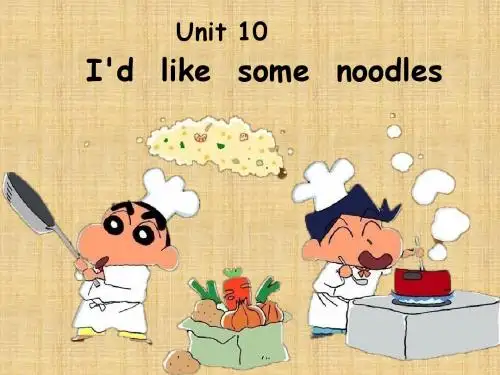
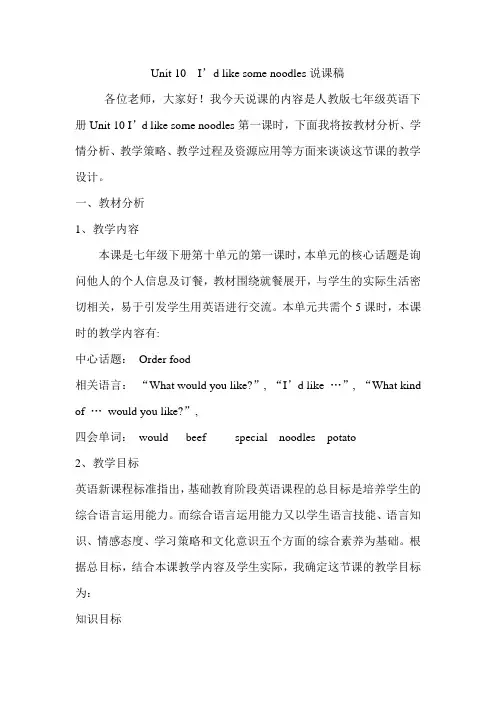
Unit 10 I’d like some noodles说课稿各位老师,大家好!我今天说课的内容是人教版七年级英语下册Unit 10 I’d like some noodles第一课时,下面我将按教材分析、学情分析、教学策略、教学过程及资源应用等方面来谈谈这节课的教学设计。
一、教材分析1、教学内容本课是七年级下册第十单元的第一课时,本单元的核心话题是询问他人的个人信息及订餐,教材围绕就餐展开,与学生的实际生活密切相关,易于引发学生用英语进行交流。
本单元共需个5课时,本课时的教学内容有:中心话题:Order food相关语言:“What would you like?”, “I’d like …”, “What kind of …would you like?”,四会单词:would beef special noodles potato2、教学目标英语新课程标准指出,基础教育阶段英语课程的总目标是培养学生的综合语言运用能力。
而综合语言运用能力又以学生语言技能、语言知识、情感态度、学习策略和文化意识五个方面的综合素养为基础。
根据总目标,结合本课教学内容及学生实际,我确定这节课的教学目标为:知识目标掌握新单词: noodles, beef, mutton, chicken, cabbage, potatoes, tomatoes, 学会would like构成的问句及回答,并能够使用该语言进行交际对话。
能力目标提高学生听说的能力,培养学生自学的能力,在学习表达点菜﹑订餐等活动中培养合作的能力。
情感目标“在用中学,在学中用”,在活动中让学生体会学习英语的乐趣,激发和培养学生学习英语的兴趣,树立学习英语的信心;模拟生活场景,在交流中增长学生生活经验,促进人际交往。
3、教学重点和难点重点:学习日常生活中有关的食物名称的单词;学会would like句型的特殊疑问句及其回答。
难点: 感悟两个疑问句的相同点和不同点;灵活应用新句型模拟生活场景进行点菜、订餐、等对话。
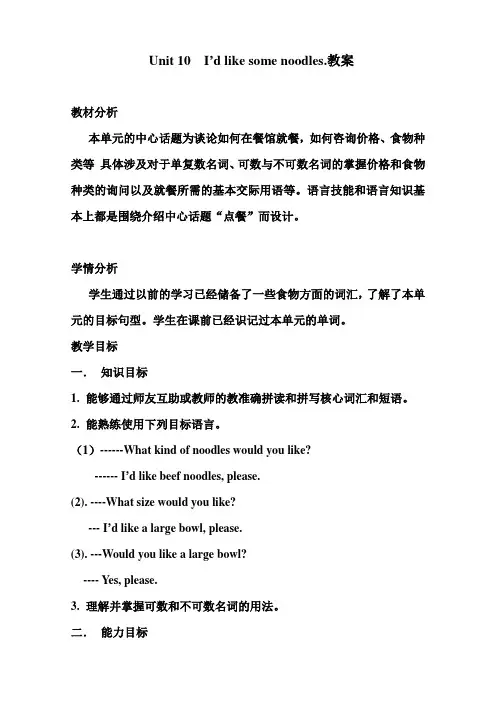
Unit 10 I’d like some noodles.教案教材分析本单元的中心话题为谈论如何在餐馆就餐,如何咨询价格、食物种类等具体涉及对于单复数名词、可数与不可数名词的掌握价格和食物种类的询问以及就餐所需的基本交际用语等。
语言技能和语言知识基本上都是围绕介绍中心话题“点餐”而设计。
学情分析学生通过以前的学习已经储备了一些食物方面的词汇,了解了本单元的目标句型。
学生在课前已经识记过本单元的单词。
教学目标一.知识目标1.能够通过师友互助或教师的教准确拼读和拼写核心词汇和短语。
2.能熟练使用下列目标语言。
(1)------What kind of noodles would you like?------ I’d like beef noodles, please.(2). ----What size would you like?--- I’d like a large bowl, please.(3). ---Would you like a large bowl?---- Yes, please.3.理解并掌握可数和不可数名词的用法。
二.能力目标1.能听懂简单的订餐的话题并获取有效信息。
2.能用正确的语言和语调朗读本单元中的对话和句型,并能用本单元所学的目标语言进行简单的交际。
3.能根据图片询问对某种事物的喜好,掌握打电话的订餐、点餐时常用的习惯用语。
了解英国和中国关于生日时吃事物的不同习俗。
4.能利用本单元学习的目标语言介绍饭店的事物及其价格。
三.情感目标1.通过对打电话订餐、餐馆点餐的学习,学会文明就餐以及尊重他人,提高人际交往的能力和实际生活的能力。
2.通过对不同食品价格的介绍,增强节俭意识。
四.文化意识目标了解中英国家生日食品的不同,在模拟的就餐情景中,学会与他人交流沟通,增强跨文化交际的意识和能力。
五.学习策略目标1.充分发挥师生双方在教学中的主动性和创造性。
2.重视学生之间的交流与合作以及动手实践与解决问题的能力,重视学生各种素质尤其是创新精神和实践能力的发展状况。
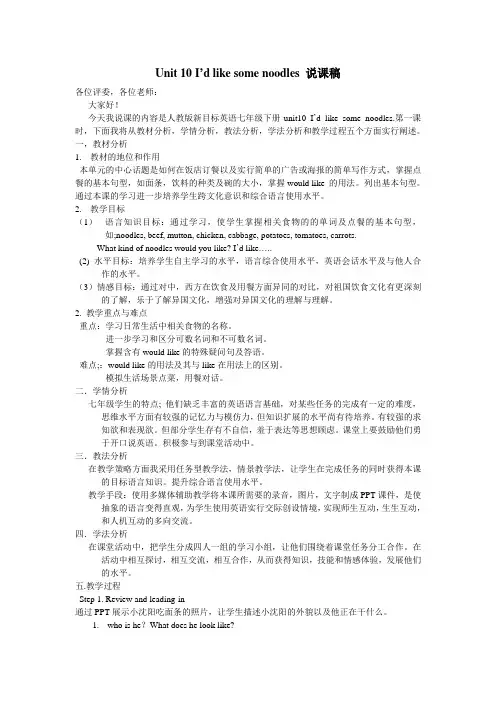
Unit 10 I’d like some noodles 说课稿各位评委,各位老师:大家好!今天我说课的内容是人教版新目标英语七年级下册unit10 I’d like some noodles.第一课时,下面我将从教材分析,学情分析,教法分析,学法分析和教学过程五个方面实行阐述。
一,教材分析1.教材的地位和作用本单元的中心话题是如何在饭店订餐以及实行简单的广告或海报的简单写作方式,掌握点餐的基本句型,如面条,饮料的种类及碗的大小,掌握would like 的用法。
列出基本句型。
通过本课的学习进一步培养学生跨文化意识和综合语言使用水平。
2.教学目标(1)语言知识目标:通过学习,使学生掌握相关食物的的单词及点餐的基本句型,如;noodles, beef, mutton, chicken, cabbage, potatoes, tomatoes, carrots.What kind of noodles would you like? I’d like…..(2) 水平目标:培养学生自主学习的水平,语言综合使用水平,英语会话水平及与他人合作的水平。
(3)情感目标:通过对中,西方在饮食及用餐方面异同的对比,对祖国饮食文化有更深刻的了解,乐于了解异国文化,增强对异国文化的理解与理解。
2. 教学重点与难点重点:学习日常生活中相关食物的名称。
进一步学习和区分可数名词和不可数名词。
掌握含有would like的特殊疑问句及答语。
难点;:would like的用法及其与like在用法上的区别。
模拟生活场景点菜,用餐对话。
二.学情分析七年级学生的特点; 他们缺乏丰富的英语语言基础,对某些任务的完成有一定的难度,思维水平方面有较强的记忆力与模仿力,但知识扩展的水平尚有待培养。
有较强的求知欲和表现欲。
但部分学生存有不自信,羞于表达等思想顾虑。
课堂上要鼓励他们勇于开口说英语。
积极参与到课堂活动中。
三.教法分析在教学策略方面我采用任务型教学法,情景教学法,让学生在完成任务的同时获得本课的目标语言知识。
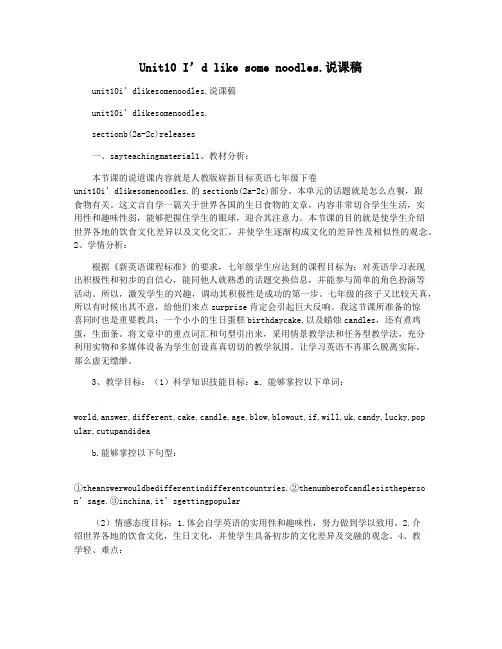
Unit10 I’d like some noodles.说课稿unit10i’dlikesomenoodles.说课稿unit10i’dlikesomenoodles.sectionb(2a-2c)releases一、sayteachingmaterial1、教材分析:本节课的说道课内容就是人教版崭新目标英语七年级下卷unit10i’dlikesomenoodles.的sectionb(2a-2c)部分。
本单元的话题就是怎么点餐,跟食物有关。
这文言自学一篇关于世界各国的生日食物的文章,内容非常切合学生生活,实用性和趣味性弱,能够把握住学生的眼球,迎合其注意力。
本节课的目的就是使学生介绍世界各地的饮食文化差异以及文化交汇,并使学生逐渐构成文化的差异性及相似性的观念。
2、学情分析:根据《新英语课程标准》的要求,七年级学生应达到的课程目标为:对英语学习表现出积极性和初步的自信心,能同他人就熟悉的话题交换信息,并能参与简单的角色扮演等活动。
所以,激发学生的兴趣,调动其积极性是成功的第一步。
七年级的孩子又比较天真,所以有时候出其不意,给他们来点surprise肯定会引起巨大反响。
我这节课所准备的惊喜同时也是重要教具:一个小小的生日蛋糕birthdaycake,以及蜡烛candles,还有煮鸡蛋,生面条。
将文章中的重点词汇和句型引出来,采用情景教学法和任务型教学法,充分利用实物和多媒体设备为学生创设真真切切的教学氛围。
让学习英语不再那么脱离实际,那么虚无缥缈。
3、教学目标:(1)科学知识技能目标:a.能够掌控以下单词:world,answer,different,cake,candle,age,blow,blowout,if,will,uk,candy,lucky,pop ular,cutupandideab.能够掌控以下句型:①theanswerwouldbedifferentindifferentcountries.②thenumberofcandlesistheperso n’sage.③inchina,it’sgettingp opular(2)情感态度目标:1.体会自学英语的实用性和趣味性,努力做到学以致用。
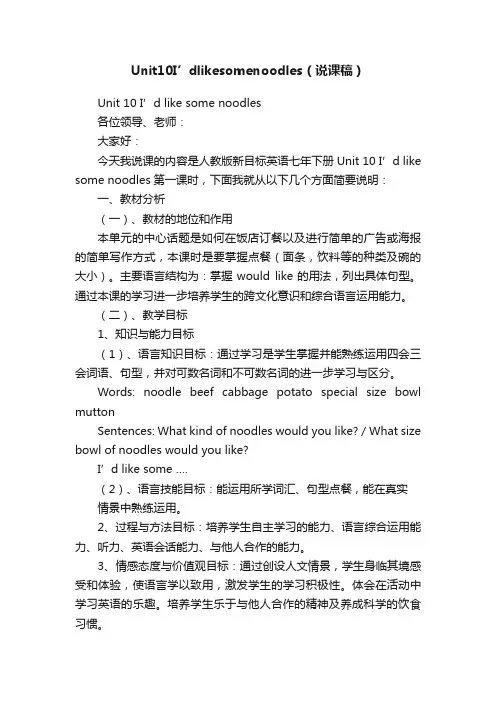
Unit10I’dlikesomenoodles(说课稿)Unit 10 I’d like some noodles各位领导、老师:大家好:今天我说课的内容是人教版新目标英语七年下册Unit 10 I’d like some noodles第一课时,下面我就从以下几个方面简要说明:一、教材分析(一)、教材的地位和作用本单元的中心话题是如何在饭店订餐以及进行简单的广告或海报的简单写作方式,本课时是要掌握点餐(面条,饮料等的种类及碗的大小)。
主要语言结构为:掌握would like的用法,列出具体句型。
通过本课的学习进一步培养学生的跨文化意识和综合语言运用能力。
(二)、教学目标1、知识与能力目标(1)、语言知识目标:通过学习是学生掌握并能熟练运用四会三会词语、句型,并对可数名词和不可数名词的进一步学习与区分。
Words: noodle beef cabbage potato special size bowl muttonSentences: What kind of noodles would you like? / What size bowl of noodles would you like?I’d like some ….(2)、语言技能目标:能运用所学词汇、句型点餐,能在真实情景中熟练运用。
2、过程与方法目标:培养学生自主学习的能力、语言综合运用能力、听力、英语会话能力、与他人合作的能力。
3、情感态度与价值观目标:通过创设人文情景,学生身临其境感受和体验,使语言学以致用,激发学生的学习积极性。
体会在活动中学习英语的乐趣。
培养学生乐于与他人合作的精神及养成科学的饮食习惯。
4、文化意识目标:通过对中、西方在饮食及用餐方面异同的对比,对祖国饮食文化能有更深刻的了解。
乐于了解异国文化,加强对文化差异的理解与认识。
5、学习策略目标:通过学习,是学生在一定程度上形成自主学习、探究学习、合作学习的习惯,有效交际、用英语思维的能力。
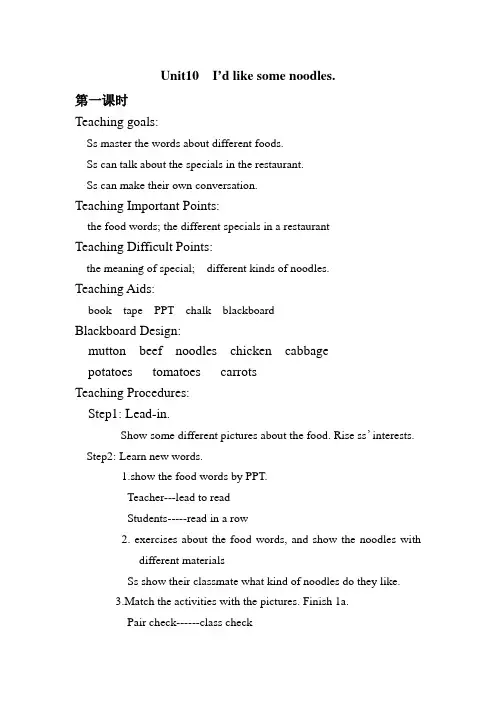
Unit10 I’d like some noodles.第一课时Teaching goals:Ss master the words about different foods.Ss can talk about the specials in the restaurant.Ss can make their own conversation.Teaching Important Points:the food words; the different specials in a restaurantTeaching Difficult Points:the meaning of special; different kinds of noodles.Teaching Aids:book tape PPT chalk blackboardBlackboard Design:mutton beef noodles chicken cabbagepotatoes tomatoes carrotsTeaching Procedures:Step1: Lead-in.Show some different pictures about the food. Rise ss’ interests. Step2: Learn new words.1.show the food words by PPT.Teacher---lead to readStudents-----read in a row2. exercises about the food words, and show the noodles withdifferent materialsSs show their classmate what kind of noodles do they like.3.Match the activities with the pictures. Finish 1a.Pair check------class checkStep3: Do the listening11.Listen and check the noodles that the person orders.“ What would you like?”“I would….”“I s there……”“yes, there is. I would like….”G----readSs----fill in the blanks.2.:Listen and repeat.3. Role-play Girls: A Boys: BStep3: Do the listening21.Listen and check the names of the foods you hear.2.Listen again, complete these sentences.3.Listen and repeat.Step4: Speaking and Writing1.Ask and answer(pair work)A: What kind of noodles would you like?B: I’d like beef noodles, please.Step5:Homework:Predict the conversation in 2d.Refection:1.在单词的学习上,除了通过图片的展示与录音的跟读,在第一步可以补充:通过分类(主食、水果、蔬菜、汤类等),这样既复习了以前上册所学,同时又让学生可以产生深刻的印象。

Unit 10 I’d like some noodles Section A, 1a–2c(说课)Unit 10 I’d like some noodlesSection A, 1a–2c(说课)大家好!非常欢迎大家和我一起研读《I’d like some noodles》这节课的教学思路,一、教材分析这节课是人教版七年级下册第十单元第一课时,本节课的中心内容是新单词和would like新句型。
注重培养学生听、说、读、写能力的进一步提高。
尤其对于生活中的交际用语起到了积极锻炼的作用,上学期学生接触过类似的情景如购物。
但需要进一步从学会点餐,也就是本课的学习来拓展交际能力,通过本节课的学习,学生与同伴交流并合作的技巧,以及人际智能和言语技能将得到很大的提高,为以后的学习奠定坚实的基础。
二、学情分析七年级的学生经过小学和初中上学期的学习之后,已经具备了一定的英语语言功底,在思维能力方面有较强的记忆力和模仿力,但知识的扩展和运用能力有待于进一步提高,在认知心理方面,学生有较强的求知欲和表现欲,并初步具备了合作探究能力。
三、教学目标在新课程理念的指导下,结合学生和教材的情况,我设计了这样的三维教学目标1. 知识与能力(1)Key words:noodles bowl would beef pork mutton chicken cabbage tomato potato broccoli carrot(2)New sentences:what kind of noodles would you like ?I’d like……noodles.what size bowl of noodles would you like ?I’d li ke a……bowl of noodles.(3)能力目标:让学生了解去饭店购面的一般程序,能清楚表达自己对食品的需求,能使用礼貌用语,如“Can I help you?” “Anything else?” Wait a moment ,please!这些都是本节课没有的内容,但语言的学习就是要让学生大量的接收外来信息,使其转化为自己的语言来解决生活中遇到的问题。
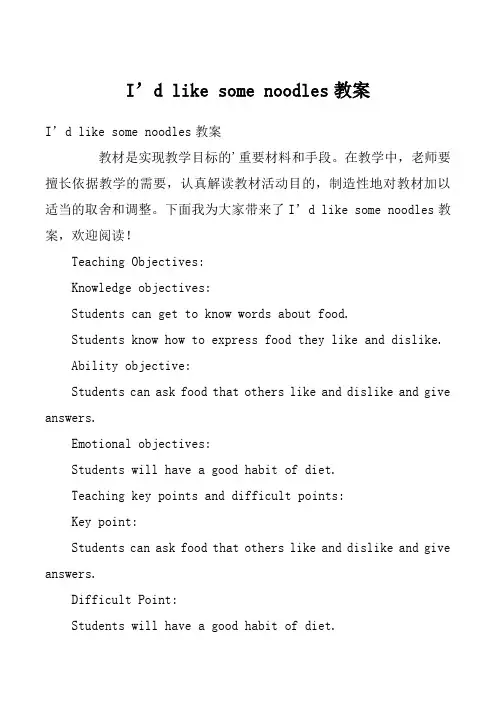
I’d like some noodles教案I’d like some noodles教案教材是实现教学目标的'重要材料和手段。
在教学中,老师要擅长依据教学的需要,认真解读教材活动目的,制造性地对教材加以适当的取舍和调整。
下面我为大家带来了I’d like some noodles教案,欢迎阅读!Teaching Objectives:Knowledge objectives:Students can get to know words about food.Students know how to express food they like and dislike.Ability objective:Students can ask food that others like and dislike and give answers.Emotional objectives:Students will have a good habit of diet.Teaching key points and difficult points:Key point:Students can ask food that others like and dislike and give answers.Difficult Point:Students will have a good habit of diet.Teaching procedures:Step 1 Lead-inGreet students and ask students to play a touching game. Show students pictures of different goods. Each group can have a set of pictures. The teacher gives the order, and students need to touch the food mentioned. See which group is fastest and correct.(Justification: Touching game can attract students’attention to the class. Students can also review words they have learned.)Step 2 Pre-listening1. Show students the picture in 1a. Ask them to match words with pictures.2. Work in pair. Ask students to talk about the food they like and dislike. The teacher shows them dialogue pattern.(Justification: In this step, students can get closer to the the topic. By working with their partners, students can begin to talk according to their own situation so that their ability of expressing themselves can be improved.)Step 3 While-listening1. Listen to the tape and complete the order form. Ask students to work in group. Each group is given a set of cards with different choices for the blank in the order form. Afterlistening to the tape, students must choose correct information and stick the card on the form.2. Listen to the tape again and check the answers.3. Listen to the tape for the third time. Ask students to read after the tape and pay attention to the stress, pronunciation, intonation.(Justification: Through three times for listening, students can get to deal with detail information in the listening material. At the same time, their speaking ability can be improved after the tape. Asking students to pay attention to the intonation which can help students understand the tone of warning. Group working can reduce difficulty in listening. )Step 4 Post-listeningRole play. Suppose that you go to a restaurant with your friends. Act out what will happen. Show them dialogue patterns.(Justification: In this step, students can use what they learned in the previous steps. Role play can help students get emerged in the real situation and talk in a more communicative way.)Step 5 Summary and homeworkSummary: Invite one student to summarize what we have learned today.Homework:Know about your parents’ diet. Ask them what they like and dislike. Share the next class.。
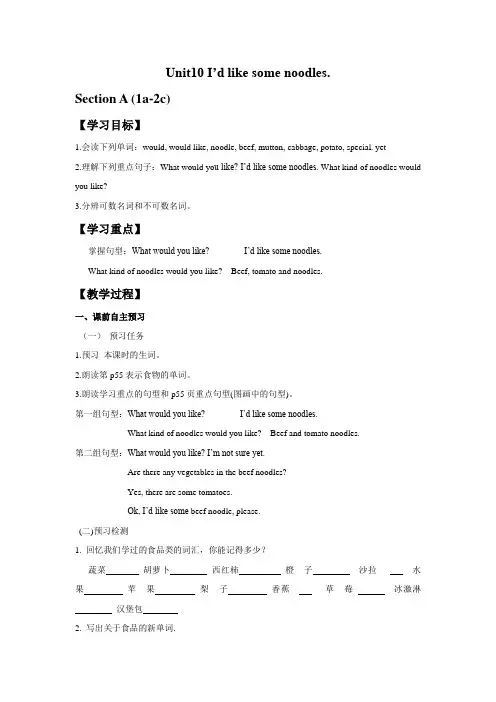
Unit10 I’d like some noodles.Section A (1a-2c)【学习目标】1.会读下列单词:would, would like, noodle, beef, mutton, cabbage, potato, special. yet2.理解下列重点句子:What would yo u like? I’d like some noodles. What kind of noodles would you like?3.分辨可数名词和不可数名词。
【学习重点】掌握句型:What would you like? I’d like some noodles.What kind of noodles would you like? Beef, tomato and noodles.【教学过程】一、课前自主预习(一)预习任务1.预习本课时的生词。
2.朗读第p55表示食物的单词。
3.朗读学习重点的句型和p55页重点句型(图画中的句型)。
第一组句型:What would you like? I’d like some noodles.What kind of noodles would you like? Beef and tomato noodles.第二组句型:What would you like? I’m not sure yet.Are there any vegetables in the beef noodles?Yes, there are some tomatoes.Ok, I’d like some beef noodle, please.(二)预习检测1. 回忆我们学过的食品类的词汇,你能记得多少?蔬菜胡萝卜西红柿橙子沙拉_______ 水果苹果________ 梨子香蕉_______ 草莓_____ _ 冰激淋_______ _ 汉堡包2. 写出关于食品的新单词.面条羊肉牛肉卷心菜马铃薯豆腐3. 将上面1、2小题的单词按要求分类:Countable noun可数名词:Uncountable noun不可数名词:Countable and uncountable noun既是可数名词又是不可数名词:4.难点释疑:What would you like ?你想要什么?Would like 意为“想要”,与want同义,表示意愿,但语气比want婉转。
可编辑修改精选全文完整版Unit10《I’d like some noodles》教学设计一、教材分析本堂课是针对七年级下册Unit 10I’d like some noodles而展开的,本课的阅读部分重点介绍了世界各地的生日饮食习惯,学生不仅要学会说语言,更要了解语言背后的文化知识,同时需要结合本课所学句型进行对话练习;此外,初中英语教学的最高境界是渗透多元文化视域,让学生以中国文化作为精神依附,有针对性地借鉴外国优秀文化成果,从而使英语教学在动态、连续的发展过程中顺应时代需求,针对本课饮食文化教学内容来说,学生需要善于捕捉时事热点,在后疫情时代,各国促生了新的礼节方式,英语课堂要引导学生了解疫情下各国的风俗礼仪,增加学生的文化积累,让学生在具体交际时能使用正确的用语和礼节,这也降低了跨文化交际错误的产生。
二、教学目标各国文化在世界范围内各自发展,文化多元化不是各国文化的相互同化或逐渐趋同,而是随着世界政治经济的高速发展,各国文化在相互吸收的基础上形成的一种相互交叉的生活方式。
本课也将从多元文化视域的角度出发,制定“多样化”的课堂设计,旨在激发学生的学习兴趣,补充生活体验,让学生的思维得到发散。
具体课堂目标设计如下:1. 知识领域:学生能够运用和掌握以下词汇:around the world、different、lucky、popular、candle、age等,掌握与饮食有关的表达、生日食品的含义;2.技能领域:运用思维导图简要复述文章大意,进行口头语段及语篇表达,并将其运用于个人讲述、集体讨论及课外采访中来。
3.情感领域:通过相关材料的学习与训练,深入体会中西方饮食文化的差异,体验生日文化气息,最终能在真实的跨文化交际中进行比较深入、得体的交流。
三、教学重难点1.教学重点:熟练掌握本课的重点单词和短语make a wish, blow out等,并了解中西方生日、饮食文化的差异;2.教学难点:学生需要掌握本课的重要语法点:the number of 与 anumber of的差别,if引导的条件状语从句,区别可数名词与不可数名词;四、教学准备基于创新教育的大背景下,教师需要在现代教育技术基础上重新审视各专业的特点,教学方式和策略也需要对照标准进一步更新,目前现代教育技术与英语教学跨领域融合的模式也给教学发展带来了新的机遇和挑战,本课教学中就采用了混合式教学模式,促进线上线下教学的相互融通,使现代教育技术与英语教学相融合。
Unit10 I’d like some noodles.
Section A(1a-2c)说课稿
各位评委、老师,大家好!今天我说课的内容是人教版七年级英语下“Unit10 I’d like some noodles.” Section A(1a-2c)第一课时。
下面我从教材内容(教材的地位和作用、教学目标、教学重难点)、学情分析、教法和学法、教学过程、板书设计和评价与反思六个方面进行如下具体阐述:
一、说教材
1、教材的地位和作用
本单元的中心话题是如何在饭店订餐或叫外卖以及进行简单的广告写作,本课的教学内容是围绕就餐展开,学习如何在饭店里订餐,掌握would like
的用法,并让学生进一步区分并使用可数名词和不可数名词。
本话题与学生的实际生活密切相关,易于引发学生用英语进行交流。
通过本课的学习将进一步培养学生的综合语言运用能力。
2、教学目标
(1)知识目标:
1)学习并掌握noodle、beef、 cabbage、potato、special、 size、 bowl、mutton等词。
2)能听懂会说以下句式,并能在实际情景中运用。
A: What would you like?
B: I’d like some...
A: What kind of noodles would you like?
B: I’d like...noodles, please.
A: What size would you like?
B: I'd like a ...bowl.
3)进一步学习与区分可数名词和不可数名词。
(2)能力目标:能用本单元的句型创造性的自编对话,培养学生自学能力、对知识的运用扩展能力,锻炼学生交际能力以及与他人合作的能力。
(3)情感目标:培养学生英语学习的乐趣和热情,做到在“在用中学,在学中用”。
(4)学习策略目标:改变传统的死记硬背,倡导自主合作学习。
3、教学重难点
重点:1、学习日常生活中有关食物的名称。
2、进一步学习与区分可数名词与不可数名词。
3、含有would like 的特殊疑问句及其回答。
难点:1、would like 的用法及其与like在用法上的区别。
2、模拟生活场景点菜、用餐等对话。
二、说学情分析
根据教学内容和七年级学生模仿能力强,语言基础差,扩展运用能力差的特点,我将教材作了一些调整与改动,第一步是将1c与2c的pair work 合并为一,编一段有关订餐的小对话,目的是突出本课重点,使订餐的过程更连贯。
第二步是让学生在认知、理解、熟悉掌握语言点的条件下再进行听力练习,让学生更容易理解对话内容和其语境,利于他们进行对话模仿练习,树立他们学习英语的自信心。
三、说教法和学法
1、说教法
《英语课程标准》强调课程从学生的学习兴趣,生活经验和认知水平出发,倡导体验、实践、参与、合作与交流的学习方式和任务型的教学途径,发展学生的综合语言运用能力。
基于上述理论和英语课程标准对学生的要求及学生的心理特点和认知发展规律,设置情景让学生自然融入到学习订餐的语境中,并激发学生的兴趣采用游戏(chant、开火车),在教学策略方面采用“任务型”教学法、情景教学法及全身反应教学法,让学生为完成任务获得必须的知识、能力、信息和文化理解,最后小组合作表演在饭店点餐,实现了任务目标、感受到成功。
本节课我运用多媒体辅助教学,将本课所需要的录音、图片、文字制成PPT课件,使抽象的语言变得直观,为学生运用英语进行交际创设情境,实现师生互动,生生互动和人机互动的多向交流。
2、说学法
《英语课程标准》把“培养学生学习英语的兴趣,树立自信心,培养良好学习习惯和形成有效策略,发展自主学习和合作精神”放在了首位。
鉴于所学单词、句型特点及学生现有知识水平,我准备引导学生采用听、说、读、写、看和动静转换的方法来学习本课。
使学生学会自主学习和合作探究,达到为用而学,用中学,学了就用的目的。
Unit10 I’d like some noodles.
Section A(1a-2c)
What kind of noodles would you like? large medium small
I’d like ... [C] [U] [C]&[U] What size would you like? potatoes beef chicken I’d like a ... Bowl. tomatoes mutton cabbage special noodles carrots
(设计意图:简洁明了,突出重点,让学生更好地理解本节课的内容。
)
六、说评价与反思
评价手段:本课我将各种活动设计成两两互动活动、游戏形式、小组合作表演、汇报展示和填写课堂自我评价表等非测试性评价手段,帮助学生学会自主学习,学会与人或团体合作,培养创新意识以及具备科学的价值观。
学生自我评价课堂活动表
班级_______________ 姓名_______________。